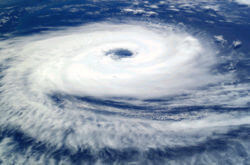 A tropical cyclone is a warm storm system fueled by thunderstorms near its center. It feeds on the heat released when moist air rises and the water vapor in it condenses. The term describes the storm's origin in the tropics and its cyclonic nature, which means that its circulation is counterclockwise in the Northern Hemisphere and clockwise in the Southern Hemisphere. Tropical cyclones are distinguished from other cyclonic windstorms such as nor'easters, European windstorms, and polar lows by the heat mechanism that fuels them, which makes them "warm core" storm systems. Depending on their location and strength, there are various terms by which tropical cyclones are known, such as hurricane, typhoon, tropical storm, cyclonic storm, and tropical depression.
A tropical cyclone is a warm storm system fueled by thunderstorms near its center. It feeds on the heat released when moist air rises and the water vapor in it condenses. The term describes the storm's origin in the tropics and its cyclonic nature, which means that its circulation is counterclockwise in the Northern Hemisphere and clockwise in the Southern Hemisphere. Tropical cyclones are distinguished from other cyclonic windstorms such as nor'easters, European windstorms, and polar lows by the heat mechanism that fuels them, which makes them "warm core" storm systems. Depending on their location and strength, there are various terms by which tropical cyclones are known, such as hurricane, typhoon, tropical storm, cyclonic storm, and tropical depression.
Tropical cyclones can produce extremely strong winds, tornadoes, torrential rain, high waves, and storm surge. They are born and sustained over large bodies of warm water, and lose their strength over land. This is the reason coastal regions can receive significant damage from a tropical cyclone, while inland regions are relatively safe from receiving strong winds. Heavy rains, however, can produce significant flooding inland, and storm surges can produce extensive coastal flooding up to 25 miles/40 km inland. Although their effects on human populations can be devastating, tropical cyclones can also relieve drought conditions. They carry heat away from the tropics, an important mechanism of the global atmospheric circulation that helps maintain equilibrium in the Earth's troposphere.
[more..]

Cyclone Catarina, a rare South Atlantic tropical cyclone viewed from the International Space Station on March 26, 2004
|
|
|

